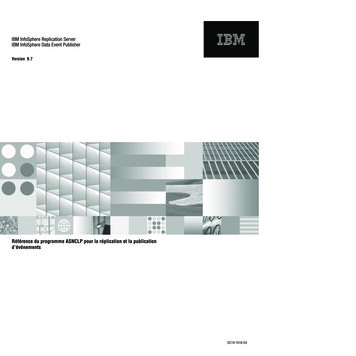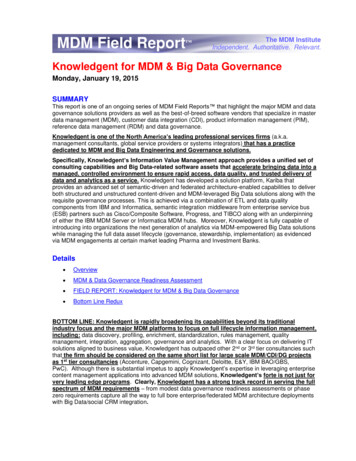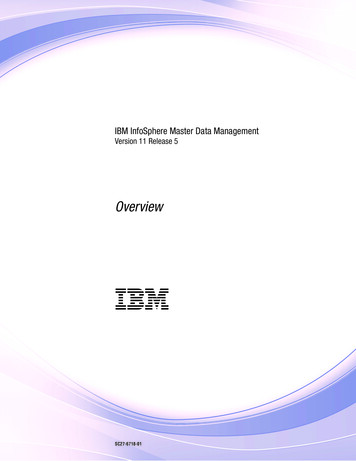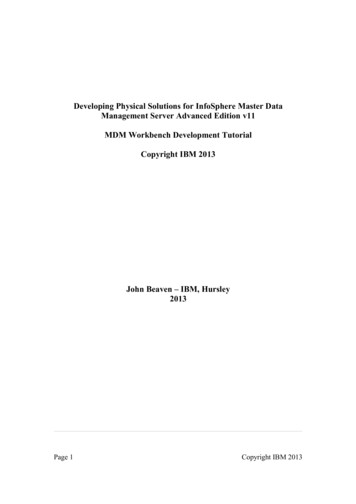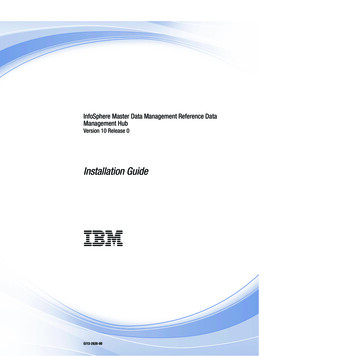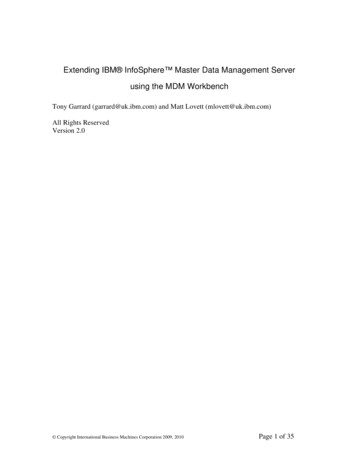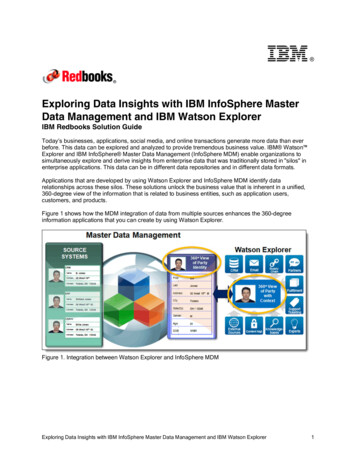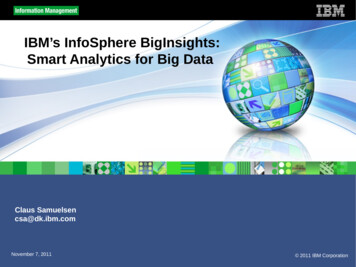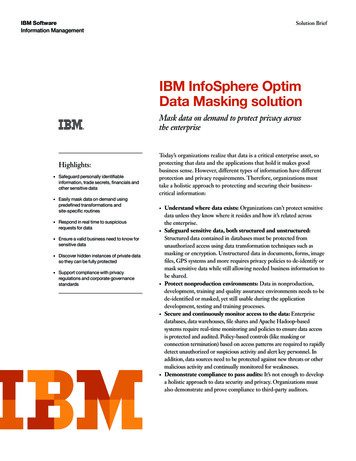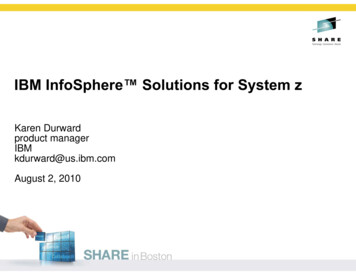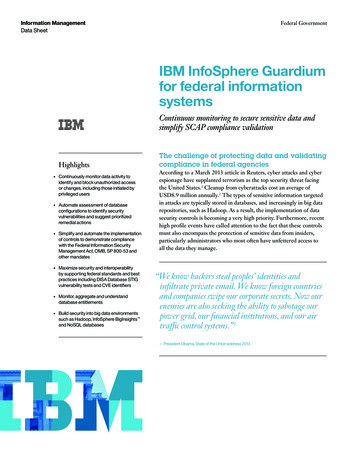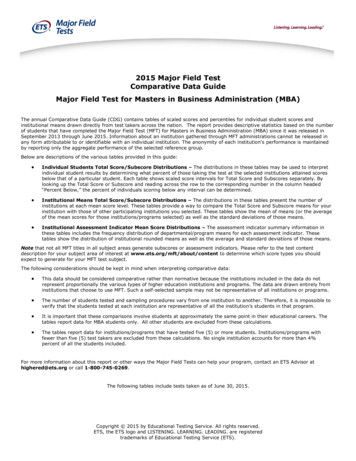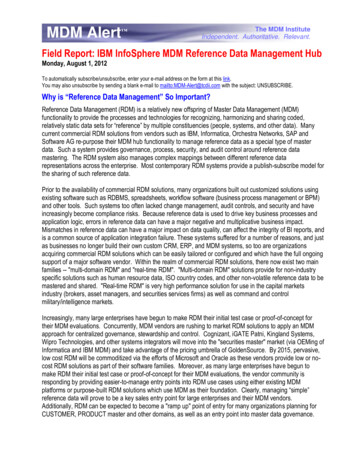
Transcription
MDM Alert The MDM InstituteIndependent. Authoritative. Relevant.Field Report: IBM InfoSphere MDM Reference Data Management HubMonday, August 1, 2012To automatically subscribe/unsubscribe, enter your e-mail address on the form at this link.You may also unsubscribe by sending a blank e-mail to mailto:MDM-Alert@tcdii.com with the subject: UNSUBSCRIBE.Why is “Reference Data Management” So Important?Reference Data Management (RDM) is a relatively new offspring of Master Data Management (MDM)functionality to provide the processes and technologies for recognizing, harmonizing and sharing coded,relatively static data sets for “reference” by multiple constituencies (people, systems, and other data). Manycurrent commercial RDM solutions from vendors such as IBM, Informatica, Orchestra Networks, SAP andSoftware AG re-purpose their MDM hub functionality to manage reference data as a special type of masterdata. Such a system provides governance, process, security, and audit control around reference datamastering. The RDM system also manages complex mappings between different reference datarepresentations across the enterprise. Most contemporary RDM systems provide a publish-subscribe model forthe sharing of such reference data.Prior to the availability of commercial RDM solutions, many organizations built out customized solutions usingexisting software such as RDBMS, spreadsheets, workflow software (business process management or BPM)and other tools. Such systems too often lacked change management, audit controls, and security and haveincreasingly become compliance risks. Because reference data is used to drive key business processes andapplication logic, errors in reference data can have a major negative and multiplicative business impact.Mismatches in reference data can have a major impact on data quality, can affect the integrity of BI reports, andis a common source of application integration failure. These systems suffered for a number of reasons, and justas businesses no longer build their own custom CRM, ERP, and MDM systems, so too are organizationsacquiring commercial RDM solutions which can be easily tailored or configured and which have the full ongoingsupport of a major software vendor. Within the realm of commercial RDM solutions, there now exist two mainfamilies -- "multi-domain RDM" and "real-time RDM". "Multi-domain RDM" solutions provide for non-industryspecific solutions such as human resource data, ISO country codes, and other non-volatile reference data to bemastered and shared. "Real-time RDM" is very high performance solution for use in the capital marketsindustry (brokers, asset managers, and securities services firms) as well as command and controlmilitary/intelligence markets.Increasingly, many large enterprises have begun to make RDM their initial test case or proof-of-concept fortheir MDM evaluations. Concurrently, MDM vendors are rushing to market RDM solutions to apply an MDMapproach for centralized governance, stewardship and control. Cognizant, iGATE Patni, Kingland Systems,Wipro Technologies, and other systems integrators will move into the "securities master" market (via OEMing ofInformatica and IBM MDM) and take advantage of the pricing umbrella of GoldenSource. By 2015, pervasive,low cost RDM will be commoditized via the efforts of Microsoft and Oracle as these vendors provide low or nocost RDM solutions as part of their software families. Moreover, as many large enterprises have begun tomake RDM their initial test case or proof-of-concept for their MDM evaluations, the vendor community isresponding by providing easier-to-manage entry points into RDM use cases using either existing MDMplatforms or purpose-built RDM solutions which use MDM as their foundation. Clearly, managing “simple”reference data will prove to be a key sales entry point for large enterprises and their MDM vendors.Additionally, RDM can be expected to become a "ramp up" point of entry for many organizations planning forCUSTOMER, PRODUCT master and other domains, as well as an entry point into master data governance.
Clearly, Reference Data Management is a major IT initiative being undertaken by a large number ofmarket-leading global 5000 enterprises. Both as an IT discipline and a commercial off-the-shelf softwaresolution, RDM solutions are being brought to market at an increasing pace. Additionally, RDM is a good entrylevel project to show success for initial MDM investment which can be built on as a data governance model.BOTTOM LINE: The July 2012 general availability release of IBM's RDM hub represents the ITindustry's first purpose-built, enterprise-strength multi-domain RDM hub. Based on what was formerlyknown as IBM MDM Server (now known as IBM InfoSphere MDM) and a co-development effort withmultiple large IBM customers, the product is an attractive enterprise-ready solution for thoseorganizations requiring reference data management. During 2012-13, organizations evaluating RDMsolutions should review their use cases and how they map to IBM's RDM hub solution, independent ofexisting IBM MDM investments.The "Field Report" Methodology2012-13 “MDM & Data Governance Road Map”. Part of the deliverables for our client Advisory Council is anannual set of milestones to serve as a "road map" to help Global 5000 enterprises focus efforts for their ownMDM programs. For planning purposes, we thus annually identify ten milestones which we then explore, refineand publish via our MDM Alert research newsletter. This set of "strategic planning assumptions" presents anexperience-based view of the key trends and issues facing IT organizations by highlighting: Master DataManagement, Data Governance, Customer Data Integration (CDI), Product Information Management (PIM),and (as of 1H2012) Reference Data Management (RDM).Thus the 2012-13 MDM road map helps Global 5000 enterprises (and IT vendors selling into this space) utilizethese “strategic planning assumptions” to help focus their own road maps on large-scale and mission-criticalMDM projects. During the following year, we use these milestones as the focus for our analyst research in thatevery research report we write either confirms or evolves one or more milestones as its premise:1. Pervasive MDM6. Social MDM2. Data governance7. Identity resolution3. Business process hubs8. Big data4. Universal MDM9. Business-critical MDM5. Reference data10. Budgets/skillsAs an industry-funded multi-client study, the MDM Institute recently released its "Reference DataManagement: Market Review & Forecast for 2012-15". Among other benefits, this industry report providesinsights into: what is RDM, what are the business drivers for RDM, what are the major use cases, what are thetechnical challenges, who are the major solution providers (software vendors and consultancies), how toevaluate such solutions, and what are the best practices for RDM in the large enterprise. Additionally, the MDMInstitute is providing a series of Field Reports which will provide details on the merits and caveats of thevariously marketed commercial multi-domain RDM solutions. Please da.html for the latest editorial calendar of such Field Reports.The majority of this Field Report on IBM's RDM hub therefore represents our analyst opinion buttressedby in-depth reviews, evaluations and (often) hands-on proof-of-concepts executed by the membershipof the MDM Institute's Advisory Council.
Evolution of IBM InfoSphere MDM Reference Data Management HubIBM's RDM hub is arguably the first-to-market commercial RDM solution. While there have been anumber of solutions that specifically address the straight through processing (STP) and real-time requirementsof the capital market industry (i.e., Asset Control, Eagle, GoldenSource, et al), IBM's RDM hub is the firstcommercial product to address the general purpose,IBM MDM Family"multi-domain" RDM market. Specifically, IBM providesout-of-the-box RDM services to centrally create, changeIBM InfoSphere MDM Standard Edition formerly Initiate Master Data Service (MDS)and distribute reference master data across anenterprise's entire landscape.IBM InfoSphere MDM Advanced Edition IBM's RDM hub is the result of an 18 month collaborationbetween IBM and two large clients: a major financialservices provider (DNB ASA), and IBM's Office of theCIO (whose "use case" is the management of allreference data relative to IBM's web sites). IBM's RDMhub was first previewed as a prototype in 2009 at IBM'slarge enterprise software user conference Information onDemand (IOD) in Las Vegas.IBM MDM Server (formerly IBM WebSphereCustomer Center & DWL) plus the formerInitiate MDSIBM InfoSphere MDM CollaborativeEdition - formerly MDM Server for PIM(formerly WebSphere Product Center)IBM InfoSphere MDM Enterprise Edition Collaboration Server plus the former InitiateMDS plus IBM MDM ServerIBM MDM Custom Domain Hub - formerlyMaster Information Hub, this OEM version ofIBM MDM Server enables customer domainsto be developed by OEMs or IT organizationsThe focus of IBM's RDM hub is delivering out-of-thebox functionality to provide and manage enterprisestrength master reference data. It is vital to note thatIBM Reference Data Management Hub - AnIBM's RDM hub makes full use of the robust customenterprise hub to manage the publishing &subscription of reference data from a centraldomain capability of IBM's market-leadingpoint which adopts an MDM approach toInfoSphere MDM technology. In other words, IBM'smanaging such dataRDM hub treats reference data as yet another type ofSource: The MDM Institutemaster data domain similar to the way the InfoSphereMDM software manages CUSTOMER and PRODUCTmaster data. This provides a number of major advantages to the deploying organization: Common MDM support services to administer and deploy Common MDM infrastructure to manage Proven extensibility in production environments Full Service-Oriented Architecture (SOA) support via InfoSphere MDM’s standard web services layer Broad commonality with the dominant IBM MDM hub in the Financial Services industry (especiallybanking and insurance) which provides a full-fledged ecosystem of trained and experienced employeesand consultantsIBM's RDM hub is designed as a pre-built, user-configurable purpose-built solution, in contrast to the toolsetapproach espoused by other vendors that require extensive coding to build a new custom domain. IBM's RDMhub can manage the reference data used within IBM's MDM and BI subsystems as well as integrate with IBM'sBusiness Glossary. The product is offered as a member of the IBM InfoSphere MDM family, and has alreadybeen tested and vetted at a number of large IBM customers
Summary Evaluation - Top 10 Evaluation CriteriaAs part of the interactions with its Customer Advisory Council, the MDM Institute captures and promotesmodels such as "top 10 evaluation criteria" for key MDM-related subsystems. During 2H2011 and as part of thebackground research for the much more comprehensive “Reference Data Management: Market Review &Forecast for 2012-15” report, more than thirty Global 5000 size enterprises shared their software evaluationprocesses and also contributed commentary and supporting details for a set of "top 10" evaluation criteria forRDM solutions. These evaluation criteria (figure 1) are discussed in more detail in the above referenced marketstudy. The majority of this Field Report in turn takes these "top 10" evaluation criteria as a framework todiscuss and understand the capabilities of IBM's RDM Hub.1. Ability to Map Reference Data - IBM RDM's underpinnings include the ability to maintain a canonical viewof reference data to enable the creation of a "standard" across the enterprise. However, not every applicationcan consume or use the canonical representation. An RDM hub therefore must be able to manage applicationspecific or local representations of a reference data set inFigure 1 addition to the canonical data set. "Maps" enable a stewardRDM Evaluation Criteriato create mapping relationships between the values indifferent sets. This includes the relationship between an1. Ability to map reference dataapplication-specific set and the canonical set. These2. Administration of reference datamapping relationships enable related values to betypesmaintained in a synchronized way and supports the3. Management of reference data setstranscoding between the codes and values of the different4. Architecturerepresentations of a set. An example in the healthcareindustry is the need to map from the World Health5. Hierarchy management over sets ofOrganization's historical ICD-9 codes to the newer ICD-10reference datacodes. This ability to map between application-specific and6. Connectivitycanonical versions of reference data is key. With IBM's RDM7. Import and exporthub solution, such RDM "maps" are treated as first class8. Versioning supportentities with their own versioning and life-cycle management.Converting values between different system formats is a9. Security & access controlcritical mapping capability ( e.g., one application10. E2E lifecycle managementrepresentation to another). IBM's RDM hub supports 1:1,Source: The MDM Institute1:many and many:many mappings between reference dataset values. Such a mapping capability makes it relativelyeasy to automatically manage how changes to a set get propagated to related sets and maps. Furthermore aschanges are made to an application-specific reference data set, the data steward (subject matter expert orSME) can easily identify those changes and determine whether they require new entries to be created.2. Administration of Reference Data Types - One of the common problems with homegrown reference datasolutions is that the many different types of reference data cannot be easily represented by a single data model.The data model needs to be constantly changed and extended to support new reference data sets, and newproperties specific to the varied types of reference data being managed. This typically requires developmentwork and IT intervention. IBM's RDM product provides a default set of out-of-the-box properties that is commonto all reference data sets - and new properties can be added to support specialized “types” of reference datawithout any coding. For example a color reference data set might require an additional property for storing thehex code for a color – with RDM a color type can be created which adds the hex code to the base set ofproperties of the default type. This ability to flexibly model reference data structures without making databasechanges (and re-generations and re-loads) reduces the need for ongoing development to support new types ofreference data. In effect, IBM's RDM hub provides a semantic layer capability transparently on top of the
relational DBMS underpinnings of the InfoSphere MDM technology. New attributes can be defined at both theset level and value level via the RDM UI without requiring any programming. Once a type has been created,new reference data sets can be created based on that type.3. Management of Reference Data Sets - IBM's design point for its RDM hub is the "business user". Byproviding intuitive UIs and a flexible data model, an enterprise can quickly install, configure and importreference data with minimal need for ongoing IT involvement. IBM's RDM hub enables reference data stewardsto immediately perform role-based CRUD (create/read/update/delete) operations over an enterprise's referencedata sets -- with full end-to-end (E2E) lifecycle management and versioning. With the business user as thedesign point, all of the UIs and stewardshipprocesses are thus defined for RDM, not MDM. ThisFigure 2 is in contrast to RDM solutions built as a customOverview of IBM's RDM Hubdomain on a multi-domain MDM platform. SuchRDM-via-custom-domain solutions typically entailSTRENGTHSmore initial implementation work than a purpose-built1. Robust solution for centralizedRDM packaged offering. In addition, the custom buildmanagement, stewardship, & distributionof enterprise reference data.approach usually requires additional developmenteffort on an ongoing basis. Furthermore, the ability2. Purpose-built, commercially proven RDMto define folders to group reference data setshubtogether, combined with search and filter functions3. Leverages IBM MDM Server asmakes organizing and finding reference data withinfoundationthe IBM RDM hub solution extremely business user4. Strong taxonomy support & mappingsintuitive -- i.e., the solution design point is the5. Ease of deployment, implementation, &business RDM user not an MDM administrator.use (very different design point fromComparatively speaking, many other RDM solutionstypical MDM)do *not* use code table mapping management but6. Market momentuminstead take a Swiss Army knife to approach RDM inthat each RDM object type is implemented as aCAVEATSseparate MDM domain.1.Lack of BPM integration & workflow(needs configurable workflow)4. Architecture - The IBM RDM hub is architected to2. Lacks Cloud architecture & SaaS offeringuse an underlying domain model designedspecifically for managing reference data which3. Perception of excessive IBM softwarestack foundation as prerequisiteleverages the base IBM InfoSphere MDM platformframework and services for security, business rules,4. Missing adapters for other IBM software(Discovery, etc.) & other majordata quality processes, events and notifications,applications such as Oracle & SAPaudit, and history. Conceptually, the solution hasSource: The MDM Institutebeen designed as a business user application whichruns as a stand-alone hub without the overhead ofany other MDM domains. Additionally, the RDM solution has been implemented as a first class MDM domainwhich utilizes the fundamental IBM MDM platform repository and frameworks such as Event & NotificationFramework, and History, etc. The RDM hub solution is fully Service-Oriented Architecture enabled andprovides/uses a series of robust web services.5. Hierarchy Management Over Sets of Reference Data - Reference code tables can be flat lists or have ahierarchical code structure. Hierarchical structure is a key #3aspectof referencedataneeds to be– Engageall levelsof thatmanagement& managedadjudicatebetweenvs. values withinin addition to the values and mapping relationships. For example,a hierarchycan centralizedbe defined overdatastewardshipa code table, or a hierarchy might be defined where each leveldecentralizedis a code tablein itsown right. IBM's RDM hubsupports creation of both types of hierarchy over reference#4data– Evolve- a hierarchykey stakeholdersover the valuesfromwithin“data a codeownership”to“datastewardship”table (a "tree hierarchy") and a hierarchy where each level is a code table in its own right (a "value hierarchy").#5 – Overcome lack of process integration incurrent “DG for MDM” offerings
An example of such a level-based hierarchy would be city/state/country where city, state, and country are eachreference data sets. These hierarchies are defined within IBM's product by creating relationships between thevalues of the sets at each level. It is both valuable and meaningful to manage the relationships between thevalues across the sets.6. Connectivity - It is vital that an RDM solution provide multiple, flexible means of connection to providemaximum "accessibility". Reference data must be made easily available to downstream application systems,remote subscribers, etc. Further, each consumer of RDM data must be able to access the data in a means andformat that is most convenient to them. Therefore, RDM solutions must be able to expose the reference data inmultiple, flexible diverse ways such as: (a) real-time channels via JMS, (b) on-demand access using SOAP orREST web services, (c) on-demand access or scheduled publication to flat and XML files, and (d) directconnections to remote databases. Each RDM channel must allow for retrieving either all data sets or lookups
known as IBM MDM Server (now known as IBM InfoSphere MDM) and a co-development effort with multiple large IBM customers, the product is an attractive enterprise-ready solution for
